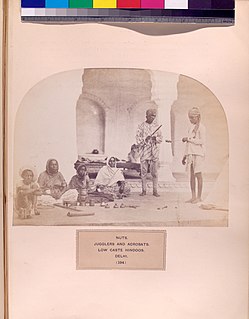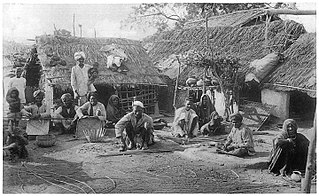Related Research Articles

The Gondi (Gōndi) or Gond or Koitur are a Dravidian ethno-linguistic group. They are one of the largest groups in India. They are spread over the states of Madhya Pradesh, Maharashtra, Chhattisgarh, Uttar Pradesh, Telangana, Andhra Pradesh, Bihar and Odisha. They are listed as a Scheduled Tribe for the purpose of India's system of positive discrimination.

The Agariya are community of the states of Madhya Pradesh and Uttar Pradesh in India. Those in the vicinity of Mirzapur were involved in mining and smelting iron during the British Raj.
The demographics of Uttar Pradesh is a complex topic, which is undergoing dynamic change. Uttar Pradesh is India's most populous state, and the largest subdivision in the world. It has a population of about 199,812,341 as per the 2011 census. If it were a separate country, Uttar Pradesh would be the world's fifth most populous nation, next only to China, India, the United States of America and Indonesia. Uttar Pradesh has a population more than that of Pakistan. There is an average population density of 828 persons per km² i.e. 2,146 per sq mi. The capital of Uttar Pradesh is Lucknow, and Allahabad serves as the state’s judicial capital. Hindus and Muslims both consider the state as a holy place.
The Sahariya are a community found in the Bundelkhand region of North India, which is administered by the states of Madhya Pradesh and Uttar Pradesh. They are also known as Rawat, Banrawat, Banrakha and Soarain.

The Chero is a caste found in the states of Bihar, Jharkhand and Uttar Pradesh in India.
The Parahiya are a Hindu caste found in the state of Uttar Pradesh in North India.

The Nat are a Hindu caste found in northern India.
Kharwar is a community found in the Indian states of Uttar Pradesh, Bihar, Jharkhand, Chhattisgarh, Orissa and West Bengal.
The Bansphor are a Hindu caste found in the state of Uttar Pradesh, India.

The Basor are a Hindu caste found in the state of Uttar Pradesh, India. They have scheduled caste status.
The Bayar, or sometimes pronounced Biyar are a Hindu caste found in the state of Uttar Pradesh in India.
The Bedia are a community in India. They believe that they originally lived on Mohdipahar and have descended from the union of Vedbansi prince with a Munda girl. The other view is that a section of the Kudmis were outcastes and came to be known as the Bedia or Wandering Kudmis.
The Bhuyan are an indigenous community found in the Indian states of Assam, Bihar, Madhya Pradesh, Odisha, Tamil Nadu, Uttar Pradesh and West Bengal. They are not only geographically disparate but also have many cultural variations and subgroups.
The Bhuiyar or Bhuyiar are a Hindu caste found in the Indian state of Uttar Pradesh. They have scheduled caste status and are also known as Bhanyar. The traditional occupation of the Bhuiyar caste is weaving but that has declined due to mechanisation.
The Khairaha are a Hindu caste found in the state of Uttar Pradesh in India. They have Scheduled Caste status.
The Jhinwar is a caste found in the states of Punjab and Uttar Pradesh in India.
On 17 July 2019, ten people were killed in a massacre in Ubbha village, Sonbhadra district, in the Indian state of Uttar Pradesh. The Gond tribals had refused to vacate land claimed by the village headman, Yagyadutt, who belonged to the dominant Gujjar community. Their resistance to his attempts to take their land led Yagyadutt to bring in goons and fire on the Gonds. The next day, the Scheduled Castes and Scheduled Tribes Commission of Uttar Pradesh asked the state government to invoke Gangster Act against the accused. The incident quickly gained national outrage as an example of caste-based killings and was taken up by the opposition as an example of the "Jungle Raj" of the Yogi Adityanath-led BJP government in the state.
References
- 1 2 People of India Uttar Pradesh Volume XLII Part Three edited by A Hasan & J C Das pages 1135 to 1138
- ↑ Darpan, Pratiyogita (July 2007). "State At A Glance - Uttar Pradesh". Pratiyogita Darpan. 2 (13): 81.
- ↑ "State wise Scheduled Tribes — Uttar Pradesh" (PDF). Ministry of Tribal Affairs, Government of India. Archived from the original (PDF) on 23 November 2016. Retrieved 4 February 2017.
- ↑ "A-10 Individual Scheduled Caste Primary Census Abstract Data and its Appendix - Uttar Pradesh". Registrar General & Census Commissioner, India. Retrieved 4 February 2017.